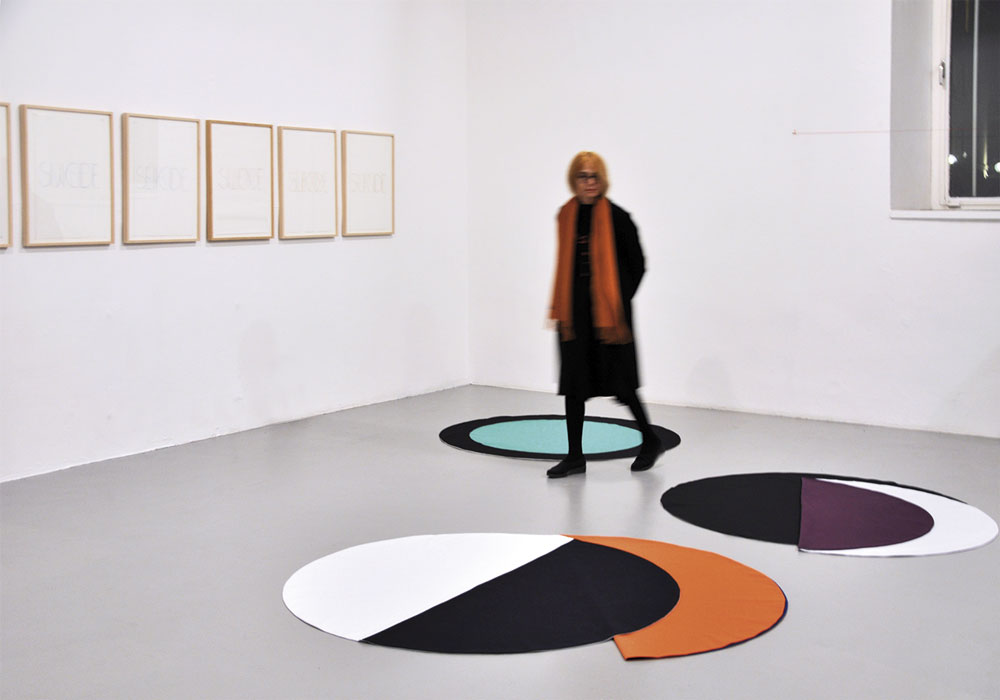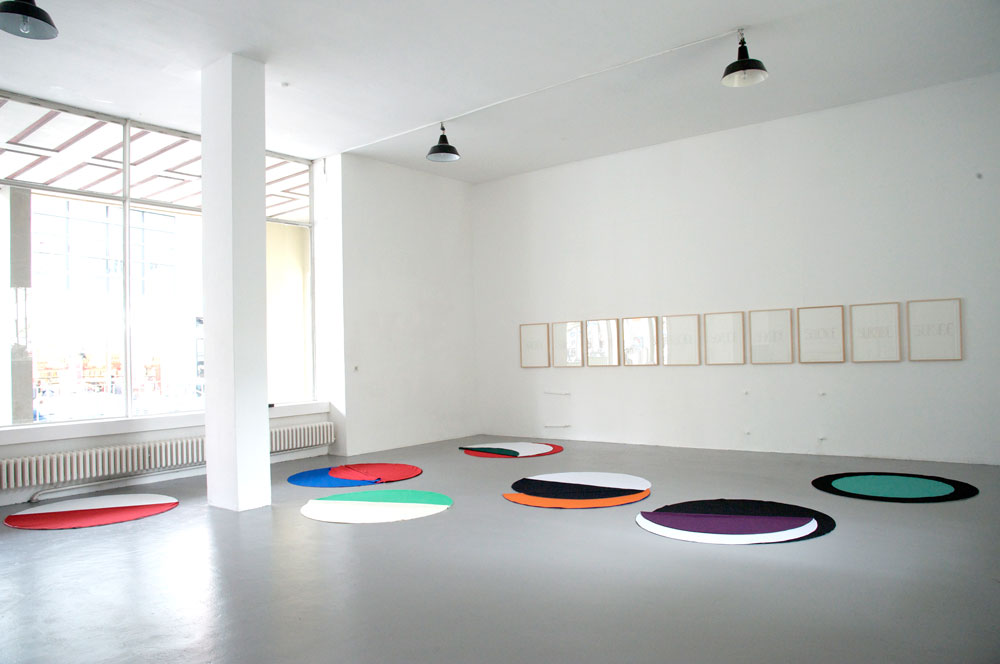Arbeiten / Ausstellungen
Einräumen
Landeshauptstadt München, Artothek & Bildersaal, 2014
Link zur Ausstellung auf muenchen.de
Raumwahrnehmung und Reflexionen über die Vieldeutigkeit von Markierungen und Signalen sind ein immer wiederkehrendes Motiv in den Arbeiten der Münchner Künstlerin Susanne Pittroff. In der Ausstellung „Einräumen“ in der Artothek, städtischer Kunstverleih und Ausstellungsraum, legt und hängt Pittroff unter anderem farbige, kreisrunde Textilobjekte aus, die gefaltet und ineinander geschoben je nach Standort des Betrachters immer neue Muster und Flächenmarkierungen ergeben. Ein scheinbar einfacher Eingriff mit fast alltäglich wirkenden, an Tischdecken erinnernden Objekten macht aus dem Ausstellungsraum einen komplexen Wahrnehmungsraum. Leitmotiv in Susanne Pittroffs Installation ist die Doppeldeutigkeit des Begriffs „Einräumen“: Einerseits kann er sich auf die Aktion beziehen, einen bestimmten Ort im Raum gegenständlich zu besetzen, andererseits lässt sich auch ein „Gedanke einräumen“, indem man ihm Raum gibt und damit die Sichtweise auf eine Sache in eine bestimmte Richtung lenkt.
Dagmar Schott M.A.
Fotos: ©Alix Stadthäuser, Susanne Pittroff
in english
Room installation at the Artothek and Bildersaal from 29 March to 3 May, 2014
Reflections on the ambiguity of marks and signals and the resultant change in spatial perception are a recurrent theme in the work of the Munich artist Susanne Pittroff. She has been focussing on interior and exterior installation art for more than twenty years, both in the public space and as part of the ‘art-and-architecture’ scheme.
The starting point of all deliberations for Pittroff’s site-related compositions, whether made for the duration of an exhibition or as permanent works of art, is always the specific situation of the space in question. Here at the Artothek she also utilises the space in a way that, on the one hand, investigates seemingly familiar experiences and concepts and, at the same time, quite specifically opens up new perspectives.
To this aim Pitroff has placed and hung multi-part, circular textile objects, among other works, on the floor and walls. New patterns were repeatedly formed by folding the materials or inserting one in another in a variety of different ways. As if arranged on an imaginary games board, the flat textile circles become position-defining fields. They claim the space they occupy, especially on account of their contrasting colours, and condition the possible positions and movements of viewers. At the same time, the appearance they have through the way they have been combined and folded at any one time can always be reworked.
The leitmotif of the exhibiton concept is the double meaning of the word ‘Einräumen’. On the one hand this can refer to the act of ‘occupying’ a certain space in a room by arranging objects as one does when moving into a house. On the other hand, it also means ‘giving thought’ to something by allowing a certain freedom and, as such, steering how something is perceived in a particular direction.
In this sense, the marking of a specific area in a room with a thread, a cord with a plumb line that is not perpendicular in this instance, is a maximum minimalistic spatial installation – barely more and yet not less than a thought rendered visible.
With such seemingly simple means Pittroff turns an exhibition room into a complex perceptual space. The viewer is invited to re-experience and re-interpret the space, time and again: how is one’s spatial perception changed through the objects introduced? What expectations and meanings are construed or removed through a concrete configuration?
The interplay of simultaneously object-related and abstract concepts forms the basis of many of Pittroff’s works. Language – often quite specifically in the form of a written word – appears as an intermediary between a physical situation and a metaphysical plane. This is also the case with the series of ten works on paper on the end wall (which one can only access after negotiating the works on the floor). Each of the drawings bears the word SUICIDE – a word that conjures up an extreme emotional situation, laden with suggestions of the Fall to the greatest human act of liberation and implying both powerlessness and the self-assurance of the decision.
There is no clarity here: superimposed between the letters S-U-I-C-I-D-E that have been drawn on the front and back of semi-transparent paper, another word can be read in each case. These are adjectives such as SOCIAL, STUPID, SUPER, SLOW or SEXY. The plane created by the added words and implications opens up space for interpretation and evokes stories – albeit minimalistically. The execution becomes iridescent. Although the words are there, these are quite clearly drawings and not writing. Susanne Pittroff employs a type of anti-typography that is intended not to make things easier to grasp.
In addition to words, surface and colour signals and their arrangement, the materials selected for the installation also play an important role. The artist contrasts, for example, the solid walls that delineate the exhibition space with objects of entirely ‘soft’ materials.
To a certain extent the harmlessness of everyday objects is inherent – a protective blanket, for example, a table cloth or a picnic rug. Other than in the case of a building, these indicate mobile places where people gather and communicate.
Whether marking and re-interpreting a space through soft materials and the bold colours of textile objects or through delicate but definite coloured threads, thoughts on Pitroff’s semantic experimental arrangements can be taken further: gender-specific characteristics could be read into the woven woollen placemats or links made to work or industry. Reflections can also be made on the availability of space or its non-availability and exclusion, on architecture’s intrinsic gesture of power and, at the same time, on its removal by the (more or less unpredictable) ‘soft’ human factor. And, not least of all, the colours and their combinations are reminiscent of flags, of political signals and space-defining regulations.
The symbolism and materials of Pittroff’s interventions in a space are open to many interpretations, especially in a social and political context and, despite their abstraction, her minimalistic spatial gestures always reach much further than the immediate sensual experience.
Dagmar Schott M.A./translation: Christipher Wynne
read less




